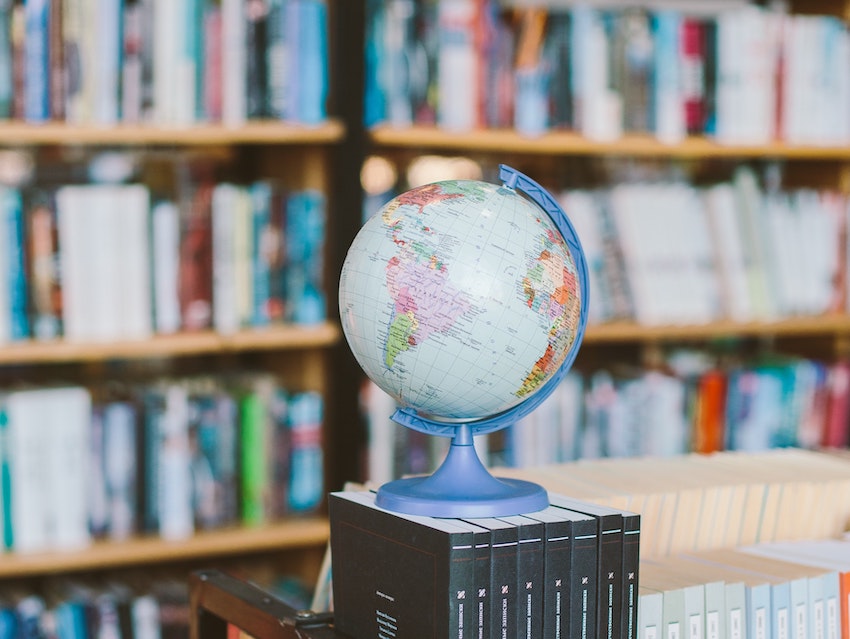The global community is more interconnected than ever, yet many of us are limited in our understanding of cultures outside our own. Reading in translation and diving into foreign language books can open up new worlds and perspectives.
The world of translated literature is like a complex tapestry, weaving together many different cultures, viewpoints, and languages. Reading in translation gives us a chance to explore foreign language books we might never have been able to read otherwise, acting as a sort of bridge between language and stories from far away right into our hands.
While literature in our native language offers comfort and familiarity, translated literature serves as a bridge to cultures, experiences, and thoughts that are different from our own. We can immerse ourselves in diverse locales, investigate unexpected views, develop a better grasp of global concerns, and build empathy for characters from other cultural origins by reading international works in translation.
But it’s important to look more closely at the benefits and potential drawbacks of reading translated books. Translators try hard to capture the heart and beauty of the original work, but sometimes little details can get lost or changed. This makes us question how well a translation conveys the original author’s meaning and style.
It is critical to recognize that translations are not necessarily exact replicas of the original material. During the translation process, linguistic subtleties, cultural allusions, and linguistic styles may be lost or altered. This can occasionally lead to misunderstandings or misinterpretations.
Still, reading in translation gives us a lot of knowledge and understanding. It introduces us to new voices, cultures, and perspectives that enrich our own view of the world. Focusing only on the limitations of translation would miss the bigger picture. In this article, we dig deeper into translated literature and see how it really affects readers all over the world.
Why should we explore foreign language books through translations?
Though often overshadowed by literature written in English, foreign language books offer profound insights into diverse cultures, worldviews, and historical contexts. Reading in translation allows us to access international literary treasures that we might otherwise miss out on due to language barriers. It’s an invitation to step outside our comfort zone and venture into new literary landscapes.
In this section, we explore both the benefits and some potential drawbacks of reading translated literature and explain how reading foreign language books in translation can be a valuable way to broaden our literary horizons.
Access to a diverse range of stories and global literary traditions
One way to experience different cultures and perspectives is through literature, particularly translated books that showcase the richness and diversity of various societies. By immersing ourselves in translated literature, we gain a deeper appreciation for the beauty of human diversity captured in a multicultural range of stories.
Translated literature could act as a linguistic bridge and promote cross-cultural contact. It allows us to appreciate the talent of writers from all around the world while also encouraging discussion between literary traditions. We are able to interact with the rich fabric of global narrative through translations and enjoy the diverse voices that would otherwise be unreachable.

By immersing ourselves in translated literature, we gain a deeper appreciation for the beauty of human diversity captured in a multicultural range of stories.
Imagine a world where every language is a thread, woven intricately into the grand tapestry of human expression. Each thread brings its own hue, texture, and resonance, forming a symphony of voices that resonate across cultures and continents.
Reading books translated from different languages allows us to traverse uncharted territories of the human heart and mind. Through the artistry of translators, who carefully weave linguistic threads to preserve the essence of the original work, we gain access to a treasure trove of narratives that are at once unfamiliar and profoundly relatable.
You gain access to styles, themes, and storytelling techniques that might be very different from what you’re accustomed to in your own language. The mental exercise involved in understanding complex narratives, multiple layers of meaning, and unfamiliar settings or customs can sharpen your cognitive skills, including critical thinking and problem-solving.
While the intention may be to offer a diverse range of stories, there is a risk that cultural nuances and subtleties can be lost or misrepresented in the process. Translating literature requires not only linguistic proficiency but also a deep understanding of the cultural context from which the work originates.
It is essential to question who has the power to decide which stories are translated and made available to a wider audience. There may be biases in favor of certain cultures or regions, leading to an incomplete representation of global literature in translation. Readers should approach translated works critically and seek out trustworthy translators who aim for authenticity and fidelity.
The richness and diversity of insights from foreign language books
Consider the lyrical prose of Spanish literature, with its passionate undertones that mirror the fiery spirit of the culture it originates from. Or delve into the intricate labyrinth of Japanese literature, where subtlety and symbolism are woven into every word, inviting readers to decipher layers of meaning. The rhythmic verses of Arabic poetry carry echoes of a rich history, while the poignant elegance of French literature paints pictures of love and introspection.
Moreover, foreign language literature is a testament to the resilience of cultures and their ability to encapsulate their collective wisdom and dreams within the pages of books. From the poignant sagas of Nordic myths to the vibrant tales of African oral traditions, each culture’s literature carries the weight of its history, its triumphs, and its struggles.
Reading in translation is like traveling to a thousand different worlds. In Haruki Murakami’s novels, you delve into complex emotional landscapes often set in urban Japan. In contrast, reading Colombian author Gabriel García Márquez plunges you into the depths of Latin American magic realism.
Translated works often carry the weight of an entire culture, offering insights into societal norms, traditions, and attitudes that are intricately woven into the narrative. Reading stories from different parts of the world can make you more globally aware, fostering empathy and understanding across cultural and national boundaries.
By immersing ourselves in these narratives, we not only appreciate the beauty of their words but also gain insights into the cultural landscapes that have shaped them. Such books not only entertain but also educate us about social norms, historical events, and cultural values we might never have encountered otherwise.
In essence, foreign language books invite us on a journey of exploration, a literary odyssey that transcends geographical borders.
Learning different language cadences through reading in translation
As we explore the realm of translated literature, we step into a kaleidoscope of narratives, emotions, and experiences that have been shaped by the unique cadences, perspectives, and cultural nuances of each language.
Immersing yourself in the pages of translated literature offers an enriching journey through the landscape of language learning. This type of engagement provides a multifaceted approach to absorbing a new language, enhancing not just your vocabulary but also your grasp of grammatical subtleties and overall comprehension skills with the translated text.

Reading in translation exposes you to an expanded range of vocabulary in your own language, including specialized or nuanced words that capture the essence of the original text. Understanding the translated sentences can give you an indirect grasp of the sentence structures in the foreign language, even if you’re not actively studying that language.
Translated works often contain idiomatic expressions, colloquialisms, and cultural references that are invaluable for anyone wishing to appreciate the fluency of the foreign language. These idiomatic elements offer a window into the mindset, culture, and social norms of native speakers, making the language learning experience far more enriching and holistic.
Yet, the journey transcends the mechanical mechanics of language, delving into the profound realm of comprehension. As you navigate the labyrinthine passages of the translated work, you uncover the underlying currents of cultural context, historical influences, and societal nuances that shape the language’s expression.
Each idiom, every turn of phrase, and the resonance of metaphors become windows into the cultural tapestry that envelops the language. Through these literary windows, you gain a deeper understanding of the soul of the original language, connecting with the thoughts and emotions of the translator(s) who gave it life.
Language learning through reading is a powerful tool that allows us to expand our vocabulary, grasp grammar nuances, and improve overall comprehension. By exposing ourselves to different sentence structures and idiomatic expressions, we develop a deeper understanding of the language’s intricacies—though indirectly—through the power of translation.
The emotional depth and resonance of translated literature
Another remarkable aspect of engaging with translated literature is the emotional resonance it can offer. By adding foreign language books to your repertoire, reading in translation uncovers emotional depth in your reading experience.
While the external trappings of a story—settings, customs, and even certain conflicts—might be rooted in a specific culture, the core emotional experiences often speak to universal human themes. Love, loss, happiness, sorrow, ambition, and fear—these are emotions that every individual, irrespective of their cultural background, can relate to.

Encountering these universal themes in a foreign context can be an enlightening experience. It serves as a poignant reminder of the shared human condition that underlies the enormous diversity of human experiences.
For instance, the pain of unrequited love can feel just as visceral whether it unfolds on the streets of Paris or in a small village in Africa. The joy of a parent at the birth of their child is as sincere in a Manhattan high-rise as it is in a rural home in India.
Granted, an author of any nationality can write these kinds of stories about different cultures, mimicking the language cadences and cultural context of the foreign language settings, but a translated work captures these contextual underpinnings in your own language.
The emotional depth that translated literature offers serves two purposes. On the one hand, it cultivates empathy by encouraging understanding and appreciation of culturally diverse motivations, emotions, and conflicts. On the other hand, it heightens emotional resonance by offering universal themes that underscore the common human experience, irrespective of linguistic or cultural differences.
Why We Often Overlook Translated Literature
There’s a wide array of foreign language books waiting to be explored, yet many people hesitate to pick them up. So why is it that translated books often get overlooked, confined to the periphery of mainstream reading habits? Here are some factors that contribute to this phenomenon:
- Limited availability and promotion: The first hurdle is often simply the availability of translated works. Bookstores and libraries in English-speaking countries may not carry a wide range of translated books, limiting the choices for readers. Even in the era of online shopping, where any book is just a click away, translated works are often not promoted as heavily as domestic titles. They can thus remain hidden, untapped resources.
- Cultural comfort zones: People naturally gravitate toward what they know. Reading is an intimate act that engages our emotions, beliefs, and worldviews. It’s comfortable to stick to authors, characters, and settings that are familiar, thereby unwittingly bypassing stories from other cultures.
- Perceived complexity: Some readers view translated literature as more difficult to engage with or understand. They may worry about missing out on the cultural nuances or think that the process of translation may have stripped away the essence of the original work. While it’s true that some complexity might be lost in translation, what is gained—access to a new worldview—is often invaluable.
- Stereotypes and preconceptions: Unfortunately, stereotypes also play a role in the underrepresentation of translated works. Readers may unconsciously associate foreign literature with specific genres or themes, such as associating Latin American literature solely with magical realism or Russian literature with dense, philosophical tomes. This narrow viewpoint can make readers miss out on the vast range of stories that exist.
- Language chauvinism: In some cases, there exists a subconscious belief that the “best” literature is written in one’s own language. Some readers believe that reading in translation might dilute the authenticity of the original work. This form of language chauvinism overlooks the fact that mastery of storytelling, insight into human behavior, and the ability to evoke emotion are not confined to any particular language or region.
- Economic factors: Translation involves considerable time, effort, and money. Publishers may be reluctant to take on the financial risk of translating, printing, and marketing a book in another language, especially if they’re unsure about its commercial viability. This, in turn, limits the range of translated literature available to readers.
- Lack of Awareness: Quite simply, many people are not aware of the incredible range of translated literature available, thereby robbing them of the joy of reading in translation.
The Art of Translation: How Translators Bring Stories to Life in a Different Language
When we read a book in translation, it’s easy to forget that what we’re reading is a mediated experience. The story, dialogue, and even the cultural nuances have been filtered through the mind and skills of a translator.
Translators play a vital role in bridging cultures and ensuring that the essence of a story is not lost in translation. Translators need to possess not just linguistic skills but also cultural acumen. They carefully navigate through the intricate web of idioms, metaphors, and cultural references to recreate the same impact in a different language.
Translation is not just a mechanical task of swapping words from one language to another; it is a complex, creative endeavor that requires a deep understanding of both the source and target languages, as well as the cultures they represent. In essence, translators are artists who recreate a narrative, working diligently to maintain its nuances, emotional tone, and meaning.
Each language reflects the culture it comes from, filled with idioms, turns of phrase, and references that may not have a direct equivalent in another language. For example, a Russian phrase about the harshness of life in Siberia might not resonate in the same way if directly translated into English, or an expression about the Brazilian Carnival might not evoke the same feelings if just mechanically rendered in Japanese.
At times, translators face the daunting task of conveying concepts that are seemingly “untranslatable” because the target language lacks a direct equivalent. They must then decide how to convey the idea in a way that is both accurate and evocative of the original text. This might involve creating new phrases, using footnotes to provide context, or sometimes letting the text speak for itself in its ambiguity, hoping that the reader will grasp its nuances.

Narratives evoke emotions, and different languages have their own unique ways of engaging the reader’s feelings. A skilled translator knows how to evoke the same emotions in the reader of the translated text as those felt by readers of the original. This involves not just the translation of words but also the rhythm, pace, and flow of sentences. The translator must consider how sentence length, structure, and vocabulary contribute to the emotional landscape of the text.
One of the greatest challenges in translation is preserving the author’s voice. Different authors have unique styles of writing, from the dense, intricate prose of Gabriel García Márquez to the minimalist, terse style of Ernest Hemingway. The translator must strive to capture not just what is being said but how it is being said, maintaining the idiosyncrasies that make each author’s work unique.
The art of translation is a complex, multifaceted task that involves much more than a simple word-for-word conversion from one language to another. Translators are unsung heroes, bridging cultural and linguistic gaps to bring the beauty and wisdom of global literature to new audiences. By reading in translation, we not only gain access to stories from around the world, but we also get to experience them through the lens of translators who open the doors to cultures other than our own.
Reading in translation is a collaborative experience
Reading a translated book can indeed be considered a collaborative experience between the reader, the author, and the translator. While the original author provides the raw material of the story—its plot, characters, themes, and initial linguistic flair—the translator serves as a kind of co-author who re-creates the work in a new linguistic and cultural context.
The Author’s Contribution
The original author’s contribution is the most apparent: the storyline, the characters, the setting, the themes, and the emotional resonance. They create a universe, populate it, give it rules (or defy them), and imbue it with meaning. The author’s work is the bedrock of any translated book and the reason it garners interest in translation in the first place.
The Translator’s Contribution
On the other hand, the translator’s contribution is subtle but equally essential. They perform a nuanced act of transformation, carrying over the story into a new language with its own rules, idioms, and cultural baggage. They decide how to navigate challenges such as idiomatic expressions, humor, cultural references, and much more. They make choices about tone, pacing, and even the nuances of characters’ dialogues, all the while striving for fidelity to the original text.
The Intersection of Two Minds
A successful translation manages to capture not only the literal meaning of the text but also its spirit, thereby embodying the literary talents and vision of both the original author and the translator.
The translator has to immerse themselves deeply in the world of the original text, understand its nuances, and then recreate that in another language. In essence, when you read a translated work, you are reading the original author through the interpretive lens of the translator.
This collaboration enriches the reading experience in unique ways, offering layers of complexity and interpretation that monolingual readers may not experience. For example, Gabriel García Márquez once praised his English translator, Gregory Rabassa, saying he preferred Rabassa’s translation of “One Hundred Years of Solitude” to his own original text. Such instances highlight how a skilled translator can amplify or clarify an author’s work.
When you read a translated book, you’re engaging with the minds of two artists: the one who originally composed the story and the one who recast it into a language you can understand. This collaboration across languages and cultures is part of what makes reading translated literature so rewarding and enriching.
Must-Read Translated Books from Around the World
If you’re new to this, here are some foreign language books in translation that can serve as your starting point:
- “One Hundred Years of Solitude” (1967) by Gabriel García Márquez (Colombia)
Translated from Spanish by Gregory Rabassa (1970)
This magical realist masterpiece delves into the history of the Buendía family over seven generations in the fictional town of Macondo. Marquez’s lush prose and intricate storytelling are beautifully captured by Gregory Rabassa, making the book an essential read for anyone interested in world literature. - “Crime and Punishment” (1866) by Fyodor Dostoevsky (Russia)
Translated from Russian by Richard Pevear and Larissa Volokhonsky (1992)
This classic novel deals with the moral dilemmas faced by a young man who tries to justify murder for a perceived greater good. Richard Pevear and Larissa Volokhonsky’s translation has garnered significant praise due to their commitment to staying as close as possible to the original text, both in terms of meaning and structure. They also strived to maintain the philosophical depth of the text, retaining its intellectual rigor and existential inquiries. - “The Wind-Up Bird Chronicle” (1994-1995) by Haruki Murakami (Japan)
Translated from Japanese by Jay Rubin (1997)
Murakami’s unique blend of magical realism, surreal events, and existential queries are brought to life by Jay Rubin’s sensitive translation. The novel takes the reader on an unpredictable journey through Tokyo and into the darker aspects of the human psyche. - “Blindness” (1995) by José Saramago (Portugal)
Translated from Portuguese by Giovanni Pontiero (1997)
This Nobel Prize-winning novel presents a harrowing tale of a city struck by a sudden epidemic of “white blindness.” Saramago’s long, flowing sentences and distinct writing style have been skillfully retained by Giovanni Pontiero, making it an equally captivating read in translation. - “My Name Is Red” (1998) by Orhan Pamuk (Turkey)
Translated from Turkish by Erdağ Göknar (2001)
Set in the 16th-century Ottoman Empire, this novel offers a historical mystery that delves into the realm of miniature painting and the tension between East and West. Erdağ Göknar’s translation brilliantly manages to sustain the intricacies of Pamuk’s prose and the richness of the cultural and philosophical themes. - “The Master and Margarita” (1967) by Mikhail Bulgakov (Russia)
Translated from Russian by Diana Burgin and Katherine Tiernan O’Connor (1995)
A critique of Soviet society wrapped in the guise of a fantastical narrative involving Satan visiting Moscow. The translation by Diana Burgin and Katherine Tiernan O’Connor captures the humor, wit, and underlying despair of the original, inviting the reader into a world of both satire and substance. - “Pedro Páramo” (1955) by Juan Rulfo (Mexico)
Translated from Spanish by Margaret Sayers Peden (1994)
This novel is often credited with pioneering magical realism in Latin American literature before it became globally renowned. It tells the haunting story of a man’s quest to find his father in a rural Mexican town where the divide between life and death is indistinct. Margaret Sayers Peden’s translation is often lauded for its linguistic grace, fluidity, and natural dialogue, all of which contribute to making the novel accessible to English-speaking readers. - “Season of Migration to the North” (1966) by Tayeb Salih (Sudan)
Translated from Arabic by Denys Johnson-Davies (1969)
This post-colonial novel addresses the complexities of identity, race, and cultural conflict. It is an insightful read for those seeking a different perspective on the interaction between the East and the West. Denys Johnson-Davies’s translation is a paragon of faithful and artful literary translation, preserving the emotional weight and psychological depth of the characters and the situations they navigate.
Finding Hidden Gems: Tips for Discovering and Choosing Translated Literature to Read
So, you’re intrigued by the idea of diving into the world of translated literature but don’t know where to start? The good news is that there are plenty of resources and strategies to help you uncover these hidden gems. Below are some tips for discovering and choosing translated books that will enrich your reading life and broaden your cultural understanding.
- Look for award winners and shortlists. Many prestigious awards focus specifically on translated works, such as the International Booker Prize, the Best Translated Book Award, and the PEN Translation Prize. These awards often release longlists and shortlists, making them a great starting point for high-quality, critically acclaimed works.
- Follow translators on social media. Translators are the unsung heroes of the literary world, and many are active on social media platforms. Following them can offer insights into the world of translation and provide recommendations for compelling foreign works that you might not discover otherwise.
- Join online communities and forums. Online reading groups, forums, and communities like Goodreads often have threads or specific groups dedicated to translated literature. These can be great places to get recommendations, read reviews from like-minded individuals, and even participate in discussions.
- Check out literature blogs and podcasts. Many literature-focused blogs and podcasts frequently cover translated books. Following such platforms can offer you new titles to consider and also provide in-depth analysis and interviews that can enrich your reading in translation experience.
- Visit specialized bookstores and libraries. Some bookstores and libraries specialize in foreign literature or have sections dedicated to translated works. Don’t hesitate to ask for recommendations; staff are often well-versed in their offerings and can guide you based on your interests.
- Experiment with genres. Don’t limit yourself to one genre or style. Different cultures excel at different kinds of storytelling. For example, if you’re a fan of mystery, why not try a Scandinavian noir? If you enjoy science fiction, there’s a rich world of translated speculative fiction from countries like China and Russia.
- Read reviews and excerpts. Before committing to a book, it might be beneficial to read reviews or sample excerpts. This gives you a sense of the book’s style, the complexity of its language, and whether the story resonates with you.
- Consult academic lists and anthologies. University courses that focus on world literature often provide reading lists that are a goldmine for discovering quality translated works. Similarly, anthologies that focus on translated short stories or poems can provide a broad sweep of what different cultures and languages have to offer.
- Trust your instincts. At the end of the day, the best way to discover a hidden gem is to trust your own instincts. If a synopsis catches your eye, or if the first few pages grip you, take a chance! The world of translated literature is vast and diverse, offering something for everyone.
By implementing these suggestions into your reading routine, you will not only discover new writers and cultures, but you will also contribute to a more global and inclusive literary scene. Have fun discovering!
Further Reading
The Art of Translation by Sophie Hughes, The New York Times
Lost in Translation: What The First Line of “The Stranger” Should Be by Ryan Bloom, The New Yorker
Who You’re Reading When You Read Haruki Murakami by Rowan Hisayo Buchanan, The Atlantic
10 Literary Translators on the Art of Translation by Emily Temple, Literary Hub
Why translators should be named on book covers, Jennifer Croft, The Guardian
Literary Translations and Crossword Puzzles Are More Similar Than You Think by May Huang, Electric Literature





